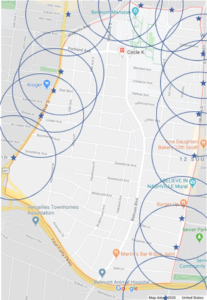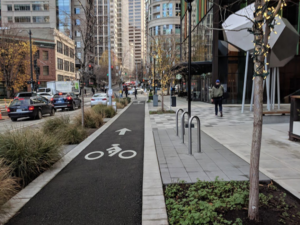Why:
It doesn’t take much thinking to know that when you increase the number of people in a neighborhood, the amount of traffic will increase. Especially in Nashville, where only 2.1% of people, according to the American Community Survey, use public transit to get to work. Therefore, when our team designed these DADUs, we knew that we would have to analyze the overall effect on Nashville’s transit and try to find solutions that improve the likelihood that people in the neighborhood, both current homeowners and future DADU residents, will choose to use public transit to get around.
Issue:
Busses tend to have a stigma around them that other public transit options, such as lite rail or trains, don’t have. Therefore there is work to be done before we can convince people to use busses as a main source of transit. We need to rebrand busses as clean, safe, and “trendy” in a way that light rails and other public transit are viewed. Nashville’s WeGo rebranding attempted to help with this issue, but the busses are still slower than personal transit and don’t run regularly in Nashville. Hence our main issue is that people still won’t ride the bus until it gets them where they need to go significantly faster or cheaper than their current form of transit.
Current Transit System:
LEED certification specifies that bus stops need to be within a quarter-mile of the residences to count towards the quality transportation credit. There are three lines around the Belmont-Hillsboro neighborhood: the 7, the 21, and the 17, running on 21st, Wedgewood, and 12 South, respectively. The bus stops around the neighborhood, and the quarter-mile circles around those stops cover Less than half of the neighborhood. This means that less than half of the people in the neighborhood have reasonable access to public transit, according to LEED’s standard. The busses also run infrequently, on average a bus will arrive every30 minutes on a given day (unless it is the 7). This infrequent service makes bus travel inconvenient for people in the neighborhood. Therefore, fewer people will take the bus as their primary, or any, mode of transportation.

All bus stops in and around Belmont-Hillsboro, with a ¼ mile radius surrounding each stop
Solution:
If there were bus lines that run through the neighborhood as opposed to just around it, more of the neighborhood would be serviced by each stop, and there can be more inter-neighborhood travel, such as to grocery stores and other shopping locations.If the line that went down Belmont Blvd, the main road through the neighborhood was still there, it would cover almost the entire neighborhood, meaning that almost everyone would live within ¼ mile of a bus stop. However, that bus line did not get enough use, and WeGo had to cut the line due to budget cuts last year. Therefore we can see that the demand for public transit is not there, even if there was another bus line.
There are a few major ideas that experts recommend to increase the likelihood that people will use transit.
- Improved bus shelters, such as ones that are obvious, have posted bus information, and provide shelter from the elements could help People be more open to waiting for the bus if they feel like they have a designated place on the sidewalk, away from the rain, wind, and sun.
- Another consideration is to create wider and more pedestrian-focused sidewalks to give people more room and display to people going through the community that pedestrians are welcome there. People are more likely to walk on sidewalks when they are wider because it seems like something enjoyable instead of simply necessary.
- The best way to encourage people to take public transit is to make it faster and more efficient so people will choose to take it over their own cars.
All of these things can increase the demand within the neighborhood and encourage new people to take transit!

A bike lane shielded from the road by shrubs, plus a widened sidewalk
One major solution that Nashville – and cities similarly sized to Nashville – is looking at is Bus Rapid Transit or BRT. BRT is a way to prioritize busses on roadways over personal vehicles and other cars so that busses can move faster and more efficiently. This prevents delays and unforeseen changes in the bus route, altogether making the bus times more predictable. BRT has proved effective in many cities of all sizes, from Houston, TX to Sydney, Australia. LEED allows for a ½ mile radius to Bus Rapid Transit stops, instead of the typical ¼ mile.
In the meantime, we can start to implement protected bike lanes to make bikers and pedestrians feel safe by providing bikers with there own space safe from car traffic. The protected bike lane protects bikers from the vehicles and gives them their own area. By increasing space for bikers and pedestrians, the neighborhood becomes more accessible without relying on vehicles. Belmont Blvd already has a bike lane, but much of the neighborhood streets do not, 21st does not, and Wedgewood only has a small shoulder. If the bike lane connects to things like grocery stores, 12 south shopping, and bus stops, people in the neighborhood can take advantage of bike lanes to get them to where they need to go, and with the connection to bus shelters, to the rest of Nashville. This is a much less expensive option than BRT, since it’s neighborhood-specific, takes up less space, and there are already some bike lanes and sidewalks in the area.
Conclusion:
This neighborhood has a lot of potential for public transit! It is served by three bus lines right now that could become high quality with more frequent service, and with one additional bus route down Belmont Blvd, most of the neighborhood would be serviced by bus. With more bike lanes and wider sidewalks, people in the neighborhood would be more likely to walk, bike, and scooter longer distances to get to stores and bus stops instead of driving those short distances, and it would better connect the neighborhood. If more analysis and outreach is done on this proposal, its implementation would help to alleviate current congestion and reduce any extra congestion due to rising densities in the neighborhood and surrounding city.
